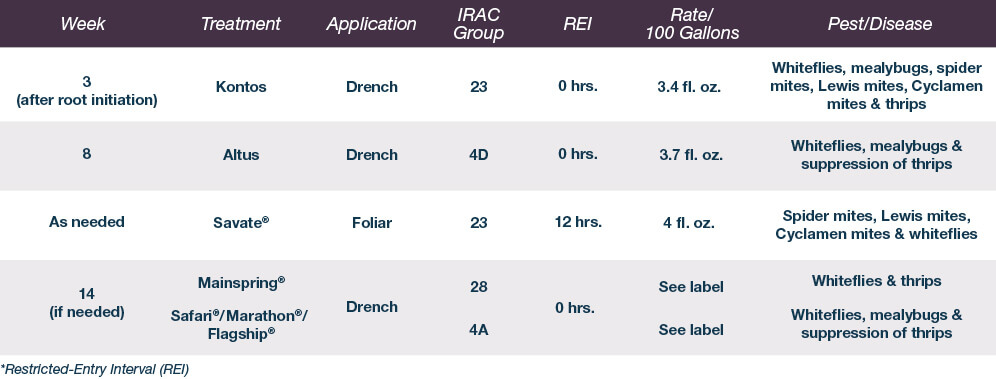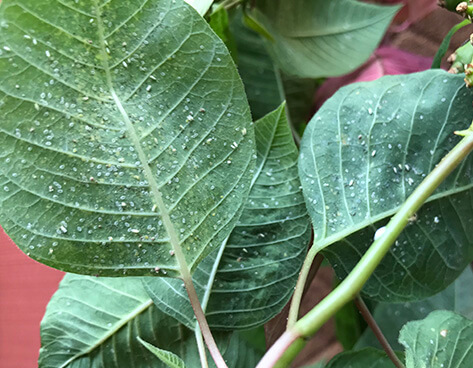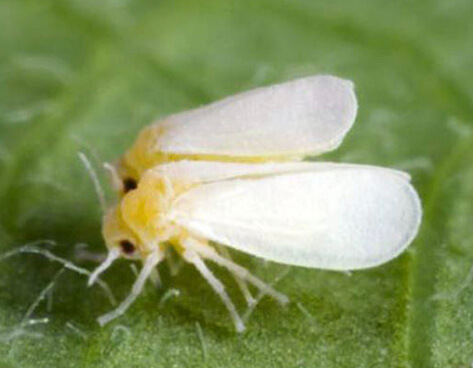Controlling Common Pests in Poinsettia Production
Pest pressure varies by region in greenhouse poinsettias, but the most common insects include whiteflies, mealybugs, mites and thrips. Poinsettias are subject to attack from insect pests and mites all season long, so effective management is a must for quality poinsettia production.
Common Pests
Whiteflies continue to be the major insect pest problem for poinsettias. Additionally, growers need to account for whitefly biotypes that have developed over the last decade or have the potential to develop insecticide resistance (i.e. MED Whitefly). Poinsettias are not a preferred host of thrips, but thrips often migrate from spring bedding plants, garden mums or weeds into poinsettias and should not be overlooked. Cyclamen mites, Lewis mites and especially spider mites should also be monitored as they are all capable of attacking poinsettias. Mealybugs can be a serious issue in warmer and tropical climates. Due to the extremely wet environment in propagation of unrooted cuttings, it is not unusual to be challenged with fungus gnat and shore fly larvae.
Symptoms
There is zero tolerance for the presence of whiteflies in today’s poinsettia marketplace. Infestations of whiteflies can be a year-round issue and often their presence (i.e. tiny white flies) can be seen before the damage is observed (i.e. chlorotic leaves with mottling). Thrips primarily attack the youngest leaves and cause distorted growth resulting in white scarring on the leaves. These symptoms can be mistaken for environmental stress, nutritional deficiencies or fertilizer damage, so it’s important to monitor for thrips activity. Mites are the smallest of the pests and feeding damage from mites often causes a bronzing of leaves. Webbing in and around the foliage is often associated with spider mite activity. Mealybugs can cause poinsettia leaves to turn yellow and plants decline in quality. Fungus gnat larvae can inhibit root development, damaging roots resulting in stunted growth. Symptoms are similar in appearance to root rot. Fungus gnat larvae can also spread fungal pathogens. Shore fly larvae do not damage the plant, but adults can leave black fecal deposits on the plant foliage and spread fungal pathogens.
Cultural Control
Good sanitation is the start to a healthy crop of poinsettia. Keep floors, walkways and sidewalls of greenhouses free from algae that can serve as a breeding area for fungus gnats and shoreflies. Adequate drainage to avoid standing water and effective water management is important to reduce plant stress. Using sticky cards to monitor insect populations and effective weed control to eliminate alternative plant hosts is recommended.
Chemical Control
Preventive insecticide applications are almost essential under growing conditions required for poinsettia production. Refer to the Envu recommendation table below for an insecticide management program focusing on drench applications. Altus® and Kontos® can also be safely applied to poinsettias as foliar sprays using rates of 14 fl. oz./ 100 gal. for Altus and 3.4 fl. oz./100 gal. for Kontos. If fungus gnat and shorefly larvae are a concern at rooting, growers can consider beneficial nematodes (Steinernema feltiae) such as NemaShield® or NemaSys® or chemical options such as Gnatrol®, Azatin®, Citation®, or Distance®.
More Information
Contact your Envu Ornamental Specialist for further assistance.
Pest Management Recommendation for Poinsettia Production

|
Various development stages of whiteflies, Photo: Envu |
Adult whiteflies (Bemisia tabaci), Photo: Envu |


